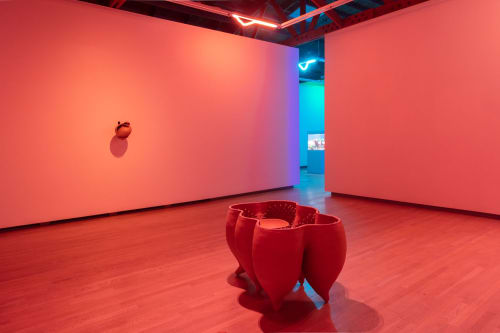The small multicolored fish swimming within Cammie Staros‘ sculptures, Figlinum aquticum, Futurum fluidum and Sculptura liqeffacta (2021) interact with different types of plants and rocks, as well as submerged ceramic vessels inspired by nature as well as classical pottery from the Greco-Roman era. While Staros’ sculptures are intricately patterned and seductively shaped, they often become backdrops for the nuanced movements of the fish continually darting around the filtered aquariums. Staros’ use of living creatures calls to mind the installations of Pierre Huyghe (who has created works to both acclaim and cutting criticism) that incorporate bees, dogs, ants or fish. Without a doubt, the inclusion of live animals changes the reception of the works because static objects cannot compete with constant dynamic movement.
In her exhibition What Will Have Being, Staros transforms the gallery into a dramatically lit immersive installation. It opens with the formal presentation of three ceramic vases, different variations of twisted natural forms, attached to steel stands or encased within a Plexiglas vitrine indicating the preciousness of the objects. The pieces are titled with Latin names like Scaphium evolutum, Mutatio naturalis, Fictile ficticium (2020), which further links them to rare specimens that might be found in natural history museums. These evocative works serve as reminders of how many classical sculptures have been removed from their historical contexts or found in shipwrecks, only to be celebrated for their unusual shapes and beauty.
Set into the wall that divides the entry from the main gallery space and open on three sides is Figlinum aquaticum, an 18 x 30 x 12-inch aquarium into which two joined terracotta pots painted black on the inside and with painted scalloped patterns on the outside is submerged. This double pot has a handle at each end and holes at the bottom. It rests on its side attached to clear acrylic supports. Within the confines of the aquarium, from the front it has the appearance of two large glowing eyes. Futurum fluidum is similarly personified. Within a tall aquarium sits a ceramic vessel painted with a decorative interlocking pattern. From one side, the pot appears symmetrical with a rounded base and tapered neck. From the verso, it resembles the abstracted curve of a woman’s body.
The main gallery space has been divided into two rooms, each with a different color glow emanating from neon fixtures attached to the gallery’s light tracks. These shaped neon tubes resemble stalactites and in some cases, Staros places puddles of colored cast glass on the floor to reinforce a sense of dripping. The green-blue hues of the front room subtly transition into a pinkish-red glow in the back room. Concha Clavata (2021) is positioned in the center of this warm, womb like space. It is a large earthenware floor-based sculpture whose insides are covered with small white porcelain spikes. The contrast between the sculpture and the aura of the room is jarring.
Staros does not limit herself to one material and in this installation juxtaposes works made from ceramic, neon and glass, as well as onyx. There are multiple ways to interpret Staros’ sculptures. They can be looked at formally and appreciated for their unusual materials. They can be seen as bridges between past and present — how her contemporary forms relate to Greco-Roman antiquities. And they can be read conceptually— as a feminist interpretation of classical forms. The inclusion of fish and her use of functioning aquariums transports these unusual works into something unexpected— at once calming and disturbing, perhaps indicative of these disconcerting times.

